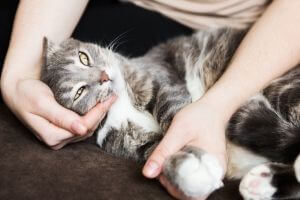We’ve all seen the memes since this COVID-19 pandemic started about dogs who have had enough of you walking them, thank you very much. And in turn, the cat memes are all about them wondering when we are going back to work and giving them their much needed personal space back. We get it. Dogs tend to be goofy and friendly while cats are, ahem, a bit more discerning about their company. The truth is, though, cats have plenty of different personality types, and many of them do experience separation anxiety. This is particularly true of cats who were orphaned. And with many of you going back to work if you haven’t gone back already, it’s a good idea to know the signs of separation anxiety in cats.
What Are The Signs My Cat May Be Experiencing Separation Anxiety?
While Every Cat Has A Different Personality, The General Signs Of Separation Anxiety In Felines Are:
- Excessive meowing, crying or moaning
- Eating too fast or not eating at all
- Excessive self-grooming
- Elimination outside the litter box
- Destructive behavior
- Excitement upon returning from home that’s out of the ordinary
- Vomiting food or hairballs
- Trying to escape
As veterinarians and pet owners, we know that some of these things can be frustrating, particularly the elimination outside the litter box. Many cat owners have gotten the “gift’ of defecation on the bed, in a shoe, or on an item of clothing. It’s important to remember that this isn’t necessarily a sign of spiteful behavior but can often mean that your cat is looking to mix their scent with yours. Cats believe they are also helping you find your way home. Instincts run deep!

What Can I Do If My Cat Shows Signs Of Separation Anxiety?
Thankfully, there are things you can buy and actions you can take to minimize the anxiety your cat may begin to feel when you return to work or other activities outside the house.
Some Of The Ways To Minimize Separation Anxiety In Cats Are As Follows:
- Leave the radio or TV on a station that is often on when you’re there
- Keep arrivals and departures low key (hint: Don’t announce, “Mommy is leaving!”)
- Create a nook, safe haven, or refuge for your cat that is their safe space
- Provide plenty of toys and/or puzzles for playtime while you are gone
- Channel prey instincts by hiding food in toys that make them work for it
- Start with shorter absences first
- Provide a perch or “catio” so that your cat can see their favorite views
- Consider a room diffuser or pheromones to provide a calming scent for your cat (check the safety of this with your vet first)
- Remove departure cues (ie) put your keys in your pocket a few minutes before leaving)
- Provide plenty of cuddles and playtime once home
- For more serious cases, consider having a sitter coming for 1-2 play sessions during absences
We cannot emphasize enough the importance of checking with your veterinarian when you see any change in your cat’s behavior before you chalk it up to separation anxiety, as early treatment of illnesses is crucial to cat wellness. For example, some cats go outside the litter box when they have urinary tract infections.
In extreme cases, medication may be an option, but your vet will usually leave that as a final alternative. As the ASPCA notes: "Sometimes for cats, veterinarians will advise using pheromones or calming treats before prescribing medication. Always consult with your veterinarian or a veterinary behaviorist before giving your dog or cat any type of medication or supplement for a behavior problem."
If you have any other questions about this or how to deal with anxiety in your cat, please don’t hesitate to give us a call.
